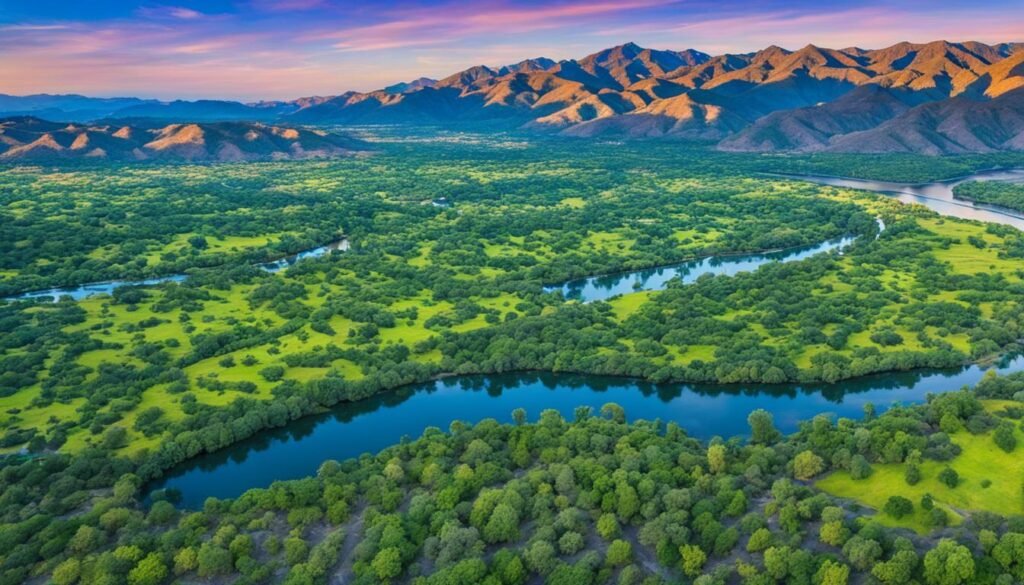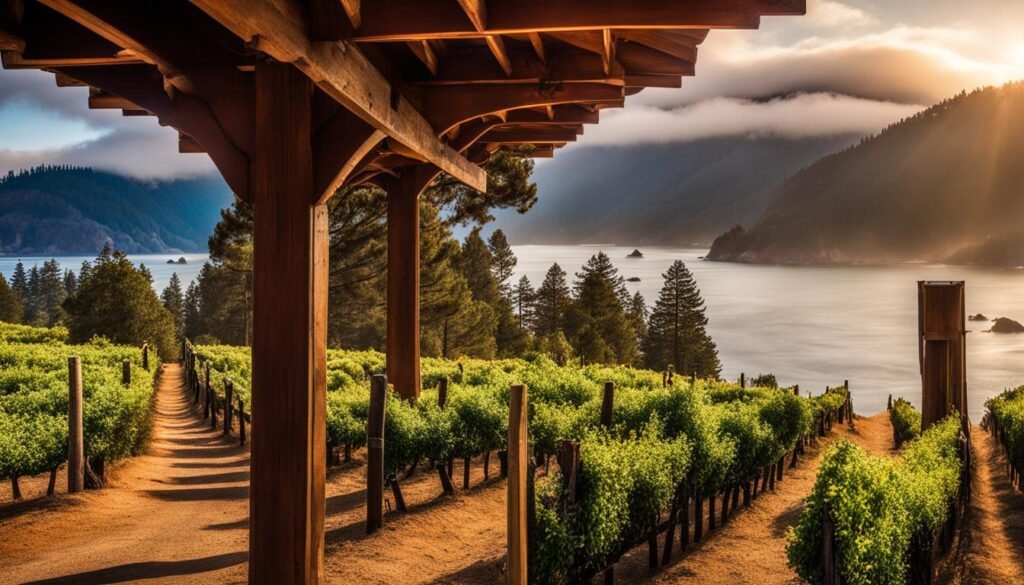The San Joaquin River is a hidden gem nestled in the heart of California. Spanning 366 miles from its source in the Sierra Nevada to Suisun Bay and the Pacific Ocean, the San Joaquin River is the longest river in Central California. This stunning waterway is renowned for its breathtaking views and diverse wildlife, making it a nature lover’s paradise.
Located in the scenic San Joaquin Valley, the river is home to several national wildlife refuges, including the renowned San Joaquin River National Wildlife Refuge and the tranquil San Joaquin Wildlife Sanctuary. These protected areas offer a glimpse into the rich biodiversity of the region, where visitors can spot a myriad of birds and other wildlife species in their natural habitats.
But the San Joaquin River is more than just a picturesque landscape. It plays a crucial role in supporting the state’s agricultural sector, serving as a vital water source for irrigation. The river is a lifeline for farmers, providing water to cultivate the fertile soil of the surrounding farmlands.
Key Takeaways:
- The San Joaquin River is the longest river in Central California.
- It is home to several national wildlife refuges, including the San Joaquin River National Wildlife Refuge and the San Joaquin Wildlife Sanctuary.
- The river supports a diverse range of wildlife, making it a paradise for birdwatchers and nature enthusiasts.
- It serves as a vital water source for irrigation, supporting the region’s agriculture.
- The San Joaquin River is a hidden gem waiting to be explored.
History and Discovery of the Benitoite Gem Mine
In 1907, I stumbled upon a fascinating discovery while exploring the scenic San Joaquin Valley in San Benito County, California. Together with my colleague, Jim Couch, we unearthed a mineral of extraordinary beauty and rarity.
What we found was a captivating mineral that would later be named Benitoite. Its unique structure featured ditrigonal dipyramids and stunning sapphire-blue crystals. It was unlike anything we had ever seen before.
The discovery of Benitoite sparked great excitement, leading to the establishment of the Dallas Mining Company. From 1907 to 1913, the company operated the renowned Benitoite Gem Mine, situated in the heart of San Benito County.
This mine was truly a gem lover’s paradise. Not only did it yield precious Benitoite gemstones, but it also produced other remarkable minerals such as natrolite and neptunite. The range of colors and formations found within the mine’s depths was simply breathtaking.
Interestingly, the Benitoite gemstones were initially mistaken for spinel due to their similar appearance. It wasn’t until esteemed geologist Dr. George Eacret, a pioneer in the field, identified them as an entirely new mineral species.
Today, the Benitoite Gem Mine stands as a revered historical site, serving as a testament to the wonders of nature. Its unique minerals continue to captivate collectors and enthusiasts alike, ensuring that the legacy of the mine lives on in the hearts of gem aficionados.


Exploring the Depths of the Benitoite Gem Mine
When you step into the Benitoite Gem Mine, you are transported into a world of natural treasures. The vibrant blue Benitoite crystals shimmer in the dim light, creating an otherworldly ambiance.
The mine’s tunnels wind their way through layers of rock, revealing hidden wonders at every turn. As you navigate through its underground maze, you’ll encounter the distinctive neptunite crystals glistening in the walls, adding a touch of mystique to the experience.
Exploring the Benitoite Gem Mine is a true adventure—one that allows you to witness the geological forces that shaped these magnificent gemstones. From the moment you set foot inside, you’ll understand why this site holds a special place in the realm of mineralogy.
The San Joaquin River: Nature’s Playground
The San Joaquin River is not only a vital water source for agriculture but also a haven for nature enthusiasts and outdoor enthusiasts. The river is home to a rich variety of wildlife, including numerous fish species such as salmon and trout, making it a popular destination for fishing.
For fishing enthusiasts, the San Joaquin River offers abundant opportunities to cast a line and reel in a variety of species. Whether you prefer fly fishing for trout or angling for salmon, the river provides a diverse array of fishing experiences for all skill levels. The calm and serene waters of the San Joaquin River create the ideal environment for a peaceful day of fishing.
In recent years, there have been significant efforts to restore and conserve the river’s ecosystem, ensuring the health and sustainability of its wildlife population. River restoration projects and conservation programs aim to preserve the natural beauty of the San Joaquin River and protect its diverse aquatic life.
Furthermore, initiatives to improve water quality in the San Joaquin River play a crucial role in maintaining the ecosystem’s health. By monitoring and enhancing water quality, conservationists and environmentalists work diligently to safeguard the river’s delicate balance.
The San Joaquin River also plays a vital role in the California water system. As a major tributary to the Sacramento-San Joaquin Delta, the river contributes to the overall water supply of the state. Its conservation and preservation are crucial for ensuring the sustainability of water resources in the region.
Immersing oneself in the natural playground of the San Joaquin River offers a unique opportunity to witness the beauty of river wildlife, engage in fishing adventures, and contribute to the conservation and restoration efforts that safeguard its ecological balance.
Exploring the San Joaquin River Valley
The San Joaquin River Valley is a true paradise for nature enthusiasts and adventure seekers. Located in central California, this stunning region offers an abundance of natural beauty and recreational opportunities for visitors of all ages.
One of the highlights of the San Joaquin River Valley is the San Joaquin River Parkway. Stretching over 20 miles, the parkway is a scenic corridor that follows the course of the river, providing a picturesque backdrop for outdoor activities. Whether you enjoy hiking, biking, or simply taking a leisurely stroll, the parkway offers a range of trails and paths to explore.


The San Joaquin River Valley is also home to several tributaries of the San Joaquin River, including the Merced River, Tuolumne River, Stanislaus River, and Mokelumne River. These waterways offer additional opportunities for outdoor exploration and water-based activities such as kayaking, canoeing, and fishing.
For those seeking a peaceful escape, the Fresno Slough is a hidden gem in the San Joaquin River Valley. This tranquil wetland area is home to a diverse range of bird species and provides a serene setting for birdwatching and wildlife observation.
When visiting the San Joaquin River Valley, don’t forget to take in the breathtaking landscapes that surround you. The valley is known for its fertile agricultural land and picturesque vistas that showcase the natural beauty of California.
So whether you’re looking for an adventure-filled getaway or a peaceful retreat, the San Joaquin River Valley has something for everyone. Discover the beauty and wonders of this remarkable region, and experience the magic of California’s waterways firsthand.
Conclusion
The San Joaquin River is a crucial natural resource that holds immense ecological importance in California. It serves as a central valley river, providing water for irrigation and sustaining the agricultural heartland of the region. Beyond its role in water management and resource allocation, the San Joaquin River nurtures a diverse range of wildlife and offers a myriad of recreational opportunities for residents and visitors alike.
Efforts revolving around river conservation and restoration have emphasized the significance of preserving the exceptional natural beauty and resources of the surrounding San Joaquin Valley. By safeguarding the river’s ecosystem and water quality, we ensure the continuity of its vital role in supporting biodiversity and maintaining a healthy environment for both terrestrial and aquatic species.
As we strive to maintain a delicate balance between human needs and ecological preservation, it becomes increasingly apparent that the San Joaquin River holds a unique position in California’s river ecology. The sustainable management of its water resources holds the key to fostering harmonious coexistence, safeguarding wildlife habitats, and ensuring a bright future for generations to come.
FAQ
What is the San Joaquin River?
The San Joaquin River is the longest river in Central California, spanning 366 miles from its source in the Sierra Nevada to Suisun Bay and the Pacific Ocean.
Where is the San Joaquin River located?
The San Joaquin River is located in California, specifically in the San Joaquin Valley.
Are there any national wildlife refuges along the San Joaquin River?
Yes, there are several national wildlife refuges along the San Joaquin River, including the San Joaquin River National Wildlife Refuge and the San Joaquin Wildlife Sanctuary. These refuges provide protected habitats for diverse wildlife species.
What is the ecological importance of the San Joaquin River?
The San Joaquin River is of great ecological importance as it supports a diverse range of wildlife and plays a vital role in the ecosystem. It is also involved in river restoration and conservation efforts to preserve its natural beauty and resources.
Why is the San Joaquin River important for agriculture?
The San Joaquin River is a crucial water source for irrigation and serves as a lifeline for farmers in the region. Its water is essential for agricultural practices and supports the growth of crops in the fertile San Joaquin Valley.
Are there opportunities for outdoor activities along the San Joaquin River?
Yes, the San Joaquin River offers numerous recreational opportunities such as fishing, hiking, biking, and picnicking. The San Joaquin River Parkway, a scenic corridor along the river, provides a perfect backdrop for outdoor enthusiasts to enjoy nature.
What other rivers are connected to the San Joaquin River in the valley?
The San Joaquin River is connected to several other rivers in the San Joaquin Valley, including the Merced River, Tuolumne River, Stanislaus River, and Mokelumne River. These rivers offer further opportunities for exploration and water-based activities.
What is the history of the Benitoite Gem Mine?
The Benitoite Gem Mine, discovered in San Benito County, California, in 1907, was home to rare minerals such as Benitoite, natrolite, and neptunite. The mine operated from 1907 to 1913 and remains a significant historical site in the region.
What water resources are connected to the San Joaquin River?
The San Joaquin River plays a vital role in the California water system as it is a major tributary to the Sacramento-San Joaquin Delta. It contributes to the overall water resources of the state.









